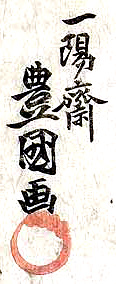Toyokuni III (Kunisada I) (1786-1864)
Kunisada, originally named Sumida Shogoro and later known as Toyokuni III, was born in 1784 in Edo. He quickly rose to prominence in the art world after studying under Toyokuni I, a leading figure in the ukiyo-e genre. By 1842, Kunisada had adopted the name Toyokuni III, aligning himself with the prestigious lineage of his master. Over his career, Kunisada became one of the most prolific ukiyo-e artists, with a body of work exceeding 20,000 prints, a testament to his extraordinary productivity and influence in the genre.
Kunisada's work primarily focused on the world of kabuki theatre, with more than half of his output dedicated to actor prints and scenes from performances, capturing the dynamic expressions and costumes with meticulous detail. In addition to kabuki subjects, he was renowned for his bijin-ga, which portrayed women of the era in various contexts, from everyday life to idealised settings, demonstrating his versatility and deep appreciation for beauty. His style, characterised by vivid colouration and a keen eye for detail, mirrored the cultural vibrancy of the Edo period.
Throughout his career, Kunisada collaborated with other notable artists of his time, such as Hiroshige and Kuniyoshi, particularly in the late 1840s to 1850. These collaborations resulted in the creation of several notable series that blended their unique skills and perspectives, enriching the ukiyo-e tradition. Kunisada's contributions to Japanese art were not only vast in quantity but also significant in their depiction of contemporary society, culture, and the evolving tastes of the Edo period, securing his legacy as a pivotal figure in the history of ukiyo-e.
Portrait of the artist Toyokuni III (Kunisada) made by his pupil Kunisada II
 |
 |
 |
 |


